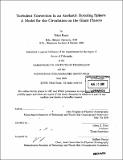Turbulent convection in the anelastic rotating sphere : a model for the circulation on the giant planets
Author(s)
Kaspi, Yohai
DownloadFull printable version (68.06Mb)
Other Contributors
Woods Hole Oceanographic Institution.
Advisor
Glenn R. Flierl.
Terms of use
Metadata
Show full item recordAbstract
This thesis studies the dynamics of a rotating compressible gas sphere, driven by internal convection, as a model for the dynamics on the giant planets. We develop a new general circulation model for the Jovian atmosphere, based on the MITgcm dynamical core augmenting the nonhydrostatic model. The grid extends deep into the planet's interior allowing the model to compute the dynamics of a whole sphere of gas rather than a spherical shell (including the strong variations in gravity and the equation of state). Different from most previous 3D convection models, this model is anelastic rather than Boussinesq and thereby incorporates the full density variation of the planet. We show that the density gradients caused by convection drive the system away from an isentropic and therefore barotropic state as previously assumed, leading to significant baroclinic shear. This shear is concentrated mainly in the upper levels and associated with baroclinic compressibility effects. The interior flow organizes in large cyclonically rotating columnar eddies parallel to the rotation axis, which drive upgradient angular momentum eddy fluxes, generating the observed equatorial superrotation. Heat fluxes align with the axis of rotation, contributing to the observed flat meridional emission. We show the transition from weak convection cases with symmetric spiraling columnar modes similar to those found in previous analytic linear theory, to more turbulent cases which exhibit similar, though less regular and solely cyclonic, convection columns which manifest on the surface in the form of waves embedded within the superrotation. We develop a mechanical understanding of this system and scaling laws by studying simpler configurations and the dependence on physical properties such as the rotation period, bottom boundary location and forcing structure. These columnar cyclonic structures propagate eastward, driven by dynamics similar to that of a Rossby wave except that the restoring planetary vorticity gradient is in the opposite direction, due to the spherical geometry in the interior. (cont.) We further study these interior dynamics using a simplified barotropic annulus model, which shows that the planetary vorticity radial variation causes the eddy angular momentum flux divergence, which drives the superrotating equatorial flow. In addition we study the interaction of the interior dynamics with a stable exterior weather layer, using a quasigeostrophic two layer channel model on a beta plane, where the columnar interior is therefore represented by a negative beta effect. We find that baroclinic instability of even a weak shear can drive strong, stable multiple zonal jets. For this model we find an analytic nonlinear solution, truncated to one growing mode, that exhibits a multiple jet meridional structure, driven by the nonlinear interaction between the eddies. Finally, given the density field from our 3D convection model we derive the high order gravitational spectra of Jupiter, which is a measurable quantity for the upcoming JUNO mission to Jupiter.
Description
Thesis (Ph. D.)--Joint Program in Physical Oceanography (Massachusetts Institute of Technology, Dept. of Earth, Atmospheric, and Planetary Sciences; and the Woods Hole Oceanographic Institution), 2008. Includes bibliographical references (p. 207-221).
Date issued
2008Department
Joint Program in Physical Oceanography; Woods Hole Oceanographic Institution; Massachusetts Institute of Technology. Department of Earth, Atmospheric, and Planetary SciencesPublisher
Massachusetts Institute of Technology
Keywords
Joint Program in Physical Oceanography., Earth, Atmospheric, and Planetary Sciences., Woods Hole Oceanographic Institution.